This will delete the page "Web Interface". Please be certain.
Using the GIN web interface
The various features of GIN are optimally accessed through a command-line interface. For cases where this is not possible, or a more simple approach is preferred, the GIN website allows quick and intuitive realization of many common tasks. This includes the creation and management of repositories, uploading files, creating and editing text files, and browsing the history of any changes made to the contents of a repository.
Contents
- Short overview
- Creating a repository
- Finding repositories
- Repository settings
- Uploading files
- Downloading files
- Deleting files
- Creating text files
- Editing text files
- Editing non-text files
- Creating an organization
- Creating a team in an organization
- Adding members to a team
- Adding repositories to an organization
- Adding repositories to a team
- Making an organization member of an owner
In Short
Repositories and collaboration
- Create a repository by clicking on the plus icon at the top right of the website and selecting "New Repository"
- Navigate to your repository from your Dashboard or the Explore page
- Change repository settings by opening the repository and clicking on "Settings"
- Change the repository name, description, and visibility on the options page of the repository settings
- Delete a repository at the bottom of the options page of the repository settings
- Collaborators can be added, invited, and managed from the collaboration page of the repository settings
Working with files
- Upload files from within a repository by clicking on "upload file" and dragging and dropping either individual files or folders into the upload area
- Download individual files by opening the file and clicking "Download"
- Delete individual files by opening the file and clicking on the trashcan icon
- Create new text files from within your repository by clicking on "New file"
- Edit text files by opening the file and clicking on the pencil icon
- Edit non-text files by modifying them on your computer and then overwriting them in your repository
Creating a repository
A repository is a folder that allows you to store, manage, and retrieve your data files. In order to start setting up a repository, click on the plus icon at the top right of the GIN website and select "New Repository".
 |
|---|
This will take you to a page where you can specify the parameters of your new repository. Choosing an owner and repository name, marked with red stars, is mandatory in order to continue. Once you have finished editing, click on the green "Create Repository" button. All options can be changed at a later time if necessary.
 |
|---|
Owner
The owner of the repository can be set to either your account or to an organization in which you have writing permissions.
Repository Name
The name of the new repository will be used to identify and link to it. A good repository name is usually composed of short, memorable and unique keywords. This name should contain only alphanumeric characters, '.', '-', and '_', and differ from the name of any other repository you have created. Please note that the incorporation of spaces or special characters such as 'ä' is not possible.
Visibility
New repositories are private by default, meaning that only the owner can view and edit files. A repository may later be shared with collaborators or set to public so that the repository and its contents is visible to anyone through the Explore page of the GIN website (or anyone that has the repository link in the case of unlisted repositories). Before changing a private repository to public, take a look at this checklist.
Description
A description may be inputted here in order to enable yourself and others to swiftly recognize what the repository contains.
.gitignore
Gitignore templates specify intentionally untracked files. You may choose one or more from the drop-down list that appears after the .gitignore field is clicked, although such templates are generally not necessary for data repositories. To remove a selected template, click on the "x" to the right of its name. More information can be found here.
License
Licenses are necessary in order to let others know what they can do with your data, and it is thus advisable to specify a license file if the contents of your new repository will be made available to individuals other than yourself. License files can either be selected from the drop-down list that appears after the License field is clicked on, or uploaded to the root of the repository at a later time. More information along with a description of the individual licenses can be found here.
Readme
A Readme file will greatly help anyone who wishes to use your data. The default README file will be added to the root of your repository and may then be edited to contain relevant information.
Initializing your repository
Ticking the "Initialize this repository with selected files and template" checkbox will instruct the website to create your new repository with the .gitignore, license, and Readme files you have indicated. The repository cannot be initialized at another time without the use of a command-line interface. Once you have completed your edits and made your selections, click the "Create Repository" button.
 |
|---|
Finding repositories
To view and manage the contents of a repository you have created or are a collaborator of using the web interface, navigate to your dashboard. From there, you can click on the name of a repository to open it.
 |
|---|
Other public repositories can be accessed by clicking "Explore" at the top of the website. Using the search feature, you can look for specific repositories or data.
 |
|---|
Repository settings
Repository settings can be accessed by clicking on the "Settings" button at the top right of your repository page.
 |
|---|
Basic Settings
The Basic Settings are located at the top of the Options page. Here, you can alter your repository name and description, add an official site, or change the visibility and whether or not a repository is listed on the Explore page of the website. Click "Update Settings" to save your changes.
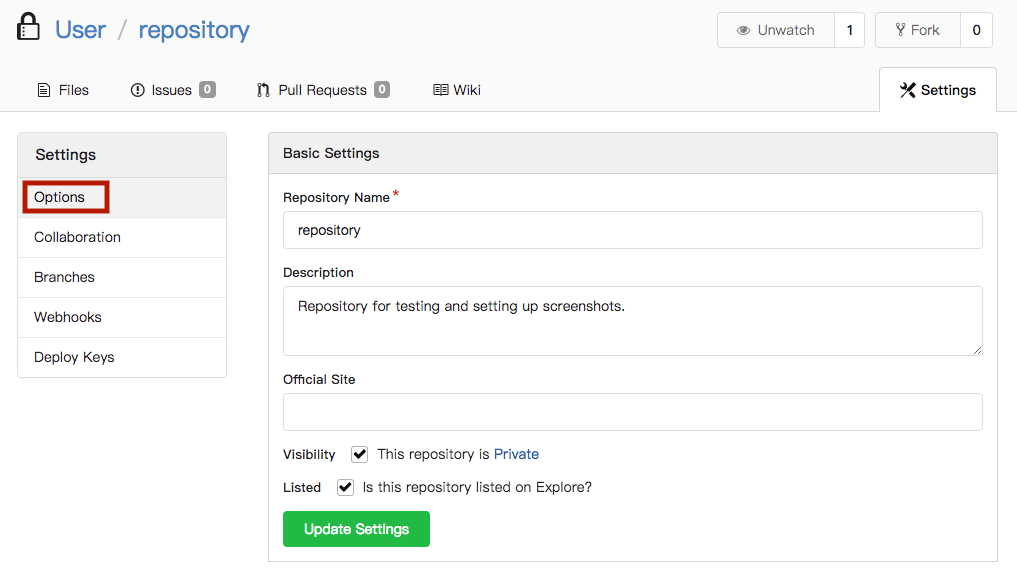 |
|---|
Deleting a repository
Scroll to the bottom of the Options page to view the Danger Zone, where permanent changes such as deleting your repository can be made. If you are absolutely sure you wish to permanently delete your repository and everything associated with it, click "Delete This Repository".
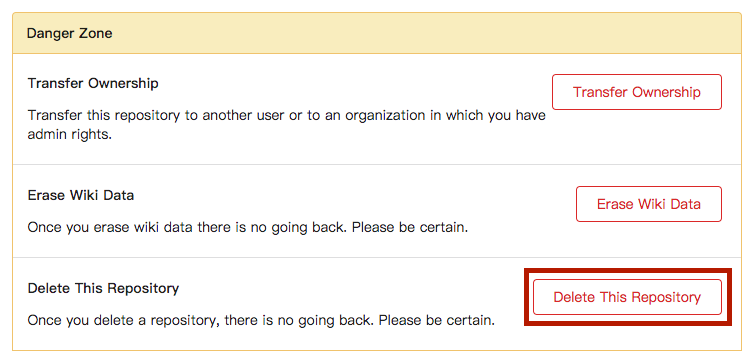 |
|---|
Type in your repository name in the window that appears, then click "Confirm Deletion".
 |
|---|
Collaboration
You can add and manage repository collaborators on the Collaboration page. To add a collaborator that is already a member of GIN, type in their username in the "Search user" field, select the correct user from the drop-down list, and click "Add New Collaborator". If you would like to share your data with someone who is not yet a member of the site, you can send them an invitation by entering their E-mail address in the lower field and clicking "Invite Collaborator". Once a collaborator has been added, you can select whether they should have admin, write, or read permissions. These settings are saved automatically. Collaborators can be removed by clicking "delete".
 |
|---|
Uploading files
To upload a file, navigate to the location within your repository where you would like to upload it to and click on the "Upload file" button.
 |
|---|
This will take you to a page where you can select the files you would like to upload. You can do this by either dragging the files to the area surrounded by a blue dotted line (a whole folder can be dragged and dropped in order to upload all the files it contains), or by clicking on the area to open a file browser. Once the upload is complete, previews with file names and sizes are displayed. You can now remove any item by clicking "Remove file", or upload additional files.
Up to 100 files, each no larger than 10 GB, may be uploaded through the web interface at one time. If a file cannot be uploaded, its preview will be overlaid with an 'X' and a red error message will appear when you move your mouse cursor over it.
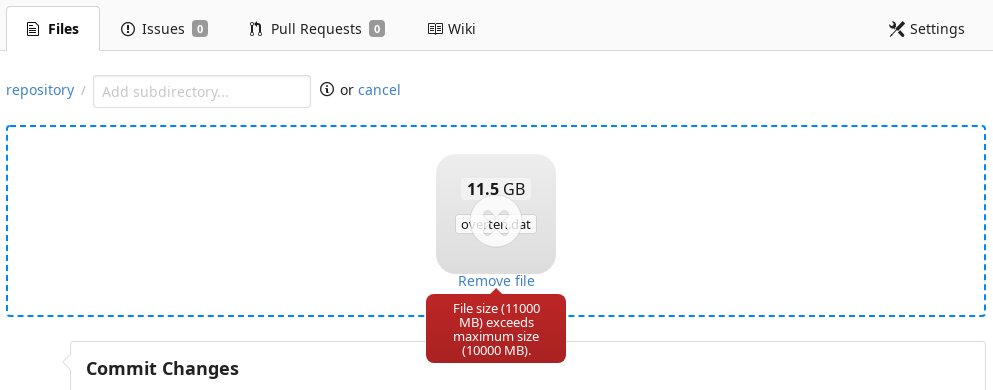 |
|---|
If you would like to upload to a different or new directory, you can modify the path accordingly in the field above the upload area. Folder names should be separated by '/'.
 |
|---|
To finalize the upload, add an appropriate commit message and click "Commit Changes" at the bottom of the page. Please note that if a file is of the same name and format as another file in the upload directory, the upload will be seen as a modification of the original file and it will be overwritten.
Downloading files
To download a file from a repository to your computer, click on the name of the file, then click "Download". This will either directly start the download or open a raw version of the file in your web browser that you can then save (right click and choose "Save As" or Ctrl+S for most browsers).
 |
|---|
Deleting files
Files can be deleted by clicking on the name of the file, then clicking the trashcan icon. Add an appropriate commit message and click "Commit Changes" at the bottom of the page. Please note that folders with no contents will be lost.
 |
|---|
File history will remain after deletion, so the file can be recovered later if needed.
Creating text files
The GIN web interface can be used to directly create text files in any repository that you have write access to. To do so, navigate to the location within your repository where the new file should be stored, then click on the "New file" button.
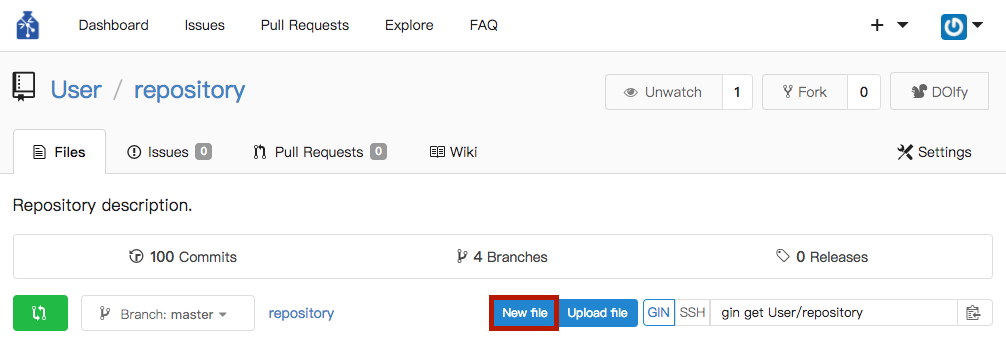 |
|---|
Files should be given a name and, optionally, an extension in the field above the text editor. If you would like to create the file in a different or new directory, you can modify the path as well. Folder names should be separated by '/'.
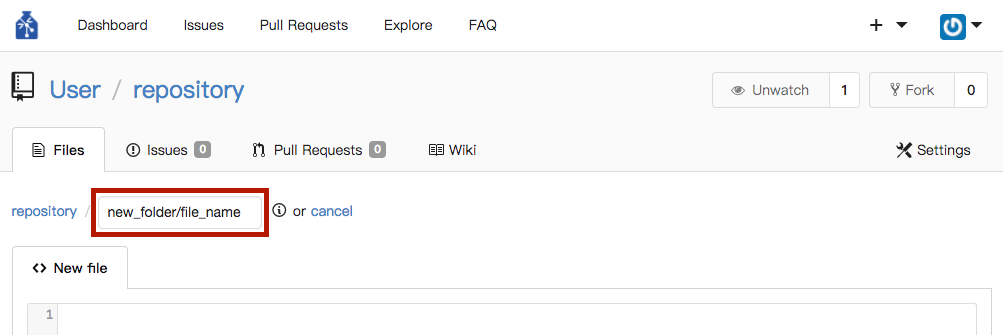 |
|---|
Giving files the Markdown (.md) extension will reveal a set of rich text editing tools. This is particularly useful when creating README files.
 |
|---|
Once you have finished editing your file, add an appropriate commit message and click "Commit Changes" at the bottom of the page. Empty files cannot be saved.
Editing text files
Text files can be modified by clicking on the name of the file, then clicking the pencil icon on the right side of the page.
 |
|---|
You can now make any needed changes in the text editor. Please note that changing the file name in the field above the text editor will not lead to the modified version being saved as a new file. The original will be updated and given the new name. You also cannot overwrite a text file by modifying a different item to have the same name, extension, and location in the web interface.
Use the "Preview Changes" tab to obtain an overview of any modifications and ensure no mistakes were made before committing them.
 |
|---|
Once you have finished editing your file, add an appropriate commit message and click "Commit Changes" at the bottom of the page. Empty files cannot be saved.
Editing Markdown files
When working on Markdown files (.md extension) such as README, you are able to use a set of rich text editing tools. Highlight the area of text you would like to format, then click on the appropriate icon in the toolbar or use a keyboard shortcut. Move your cursor over the tool icons for a description of their use and corresponding keyboard shortcuts.
The rightmost eraser tool can be used to remove formatting from a selected area, although it is advisable to do so manually (select your text and click the formatting tool again, or delete all associated tags) as the function does not detect formatting correctly in all cases.
You can also make use of the functions listed below and more by directly typing in the tags. A detailed guide can be found here.
Emphasis
 |
|---|
Select your text and click the appropriate tool to make it bold (B), italic (I), or crossed out (S).
Headers
 |
|---|
Header sizes H1 (large) through H6 (small) can be used by selecting your text and clicking the appropriate tool. H1, H2, and H3 have dedicated tools. The header tools with up and down arrows can be used to adjust size and access H4-H6. H1 and H2 are followed by a horizontal line.
Code
 |
|---|
Select your text and click the code tool to create inline code or a code block. Syntax is highlighted automatically.
Block
Of
Code
Quotes
 |
|---|
You can format text as a quote by selecting it and clicking the quote tool.
Example quote
Lists
 |
|---|
Type each item in your list on a new line, then select the whole list and click a list tool (bulleted or numbered). Note that it does not matter what number is in front of an item in a numbered list, the list will be automatically numbered from top to bottom.
- Bulleted
- List
- Numbered
- List
Hyperlinks
 |
|---|
Select the text you would like to make into a link, then click the hyperlink tool. Place the URL of the website you would like to link to in the parentheses that appear.
Images
 |
|---|
To add an image to your file, select the spot you would like the image to be displayed in and click the image tool. The URL of the image should be placed in the parentheses that appear. Optional alternate text can be written in the square brackets.
Tables
 |
|---|
Unlike other tools, the table tool should be used before adding your text. Replace the example column headers and text with your table contents. The table can be modified and expanded as desired. Items should be separated by pipes (|) to place them in different columns. Each line will be displayed as a new row. Note that alignment in the editor is not important.
| A | B | C | D |
|---|---|---|---|
| 1 | 3 | 5 | 7 |
| 2 | 4 | 6 | 8 |
Horizontal Lines
 |
|---|
Clicking on the line tool will add the following horizontal line to your document.
Preview and commit
In addition to being able to preview changes as is possible for all text files, you can also preview how your formatting will be displayed before committing by using the "Preview" tab when editing Markdown files.
 |
|---|
Once you have finished editing your file, add an appropriate commit message and click "Commit Changes" at the bottom of the page. Empty files cannot be saved.
Editing non-text files
Although non-text files such as images, Microsoft Office documents, and videos cannot be edited directly in the web interface, you can make changes by altering the file on your computer and uploading the new version with the same name and extension to the same location. This will result in the upload being tracked as a modification of the original file.
Creating an organization
- Sign in to your GIN account, you will be taken to the main page. Click on the "+" (create) button at the top right of the main page and click on the "New Organization" at the dropdown menu.
- You will be taken to a page asking for the name of your organization, enter your organization name and proceed with "Create Organization" button. Alternatively, you could create a new organization by clicking on your user name on top left of the main page/dashboard. A dropdown menu including "+ New Organization" will show up and you will be taken to the same "Create Organization" page.
Creating a team in an organization
- Sign in to GIN, you will be taken to the main page. Click on your username at the top left of the main page, a dropdown menu will pop up. Select your organization from the dropdown menu and you will be taken to your organization page.
- Click on "View 'your organization name'" at the top right corner of the page and you will be taken to a new page. At the bottom right corner of the new page, you will see "Create a new team" button, click on that and you will be taken to a new page.
- Enter your team name and a short description if necessary. Choose a level of permission for your team (read permission, write permission, administrator) and click on "Create a new team". These attributes can be changed anytime by clicking on the "Settings" button at the team webpage.
Adding members to a team
- Sign in to GIN, you will be taken to the main page. Click on your username at the top left of the main page, a dropdown menu will pop up. Select your organization from the dropdown menu and you will be taken to a new page. Click on "View 'your organization name'" at the top right corner and you will be taken to your organization page. Alternatively, you can click on "Organizations" button on the top right of the main page (next to Repositories button) and click on your organization name to go to your organization page directly.
- At the bottom right corner of your organization page, you will see a list of teams, click on the team that you want to add new members.
- You will see a slot to enter the username of the new team member and "Add team member" button next to it. Enter the username and hit "Add team member".
Adding repositories to an organization
To add a repository to an organization, you should be an owner of that organization. You can see a list of organization owners by clicking on "Owners" on the team list at organization page.
- Sign in to GIN, you will be taken to the main page. Click on your username at the top left of the main page, a dropdown menu will pop up. Select your organization from the dropdown menu and you will be taken to a new page. Click on "View 'your organization name'" at the top right corner and you will be taken to your organization page! Alternatively, you can click on "Organizations" button on the top right of the main page (next to Repositories button) and click on your organization name to navigate to your organization page directly.
- Click on "New Repository" button on top of the page and you will be navigated to a new page. Enter a repository name and description, click on "Create repository" button at the bottom of the page.
Adding repositories to a team
- Sign in to GIN and go to organization page including the team that you want to add a new repository.
- Click on the team name from the “Teams” list which is at the right bottom of the page and you will be taken to your team page.
- Click on “repositories” button on the left side of the page, next to the “members” button.
- Enter your repository name and click on “Add Team Repository”.
Making an organization member an owner
To give owner permissions to a member in an organization, an owner needs to add the user to the owners team, which is a default team in all organizations. To do that follow the steps below:
- Sign in to GIN and go to the webpage of the organization that you want to add a new owner.
- Click on "Owners" from the “Teams” list which is at the right bottom of the page and you will be taken to owners team page.
- Enter a username and click on “Add team member”.